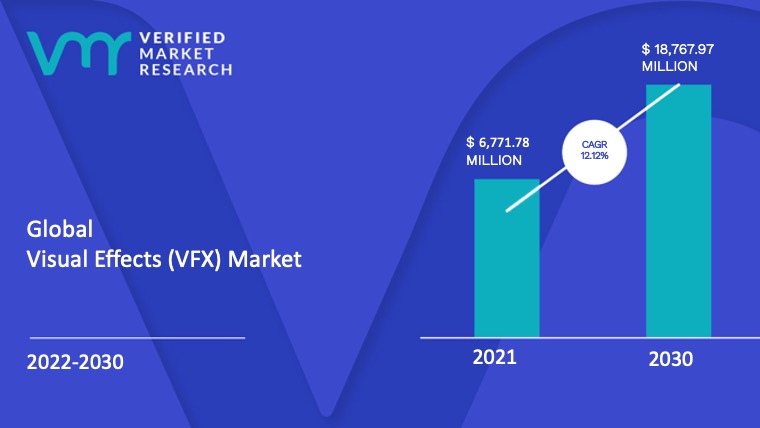
Art of Game VFX: A Deep Dive into the World of Video Game Visual Effects
- By Yuriy Denisyuk
- 02-03-2023
- Technology
Video game visual effects (VFX) are different ways of generating and/or manipulating images to give more emphasis, emotion, or intensity to any scene in a video game. VFX can be applied to gameplay elements, such as characters, weapons, or explosions; or environmental elements, such as weather, lighting, or shadows.
Video game visual effects are important because they can enhance the realism, attractiveness, and immersion of a video game. VFX can also support the narrative, gameplay, and artistic vision of a video game by creating impossible worlds, conveying information, or expressing emotions.
Visual Effects (VFX) Market Size And Forecast
The global VFX market is expected to witness significant growth in the coming years, driven by factors such as:
- The rising demand for high-quality content with realistic and immersive visuals.
- The increasing use of digital video streaming outlets such as Netflix, Amazon Prime Video, Disney+, etc.
- The growing technological advancements such as augmented reality (AR), virtual reality (VR), artificial intelligence (AI), cloud computing, etc.
- The expanding scope of VFX applications across various industries such as entertainment, education, healthcare, tourism, etc.
According to various market research reports, the global VFX market size was valued at USD 6.79 billion in 2020 and is projected to reach USD 18.77 billion by 2030, growing at a compound annual growth rate (CAGR) of 12.12% from 2022 to 2030.

Fundamentals of Video Game Visual Effects
Video game visual effects (VFX) are different ways of generating and/or manipulating images to give more emphasis, emotion, or intensity to any scene in a video game. VFX can be applied to gameplay elements, such as characters, weapons, or explosions; or environmental elements, such as weather, lighting, or shadows.
In this blog post, we will explore the role, process, and types of video game VFX.
The Role of VFX in Video Games
Visual effects play an important role in video games because they can:
- Enhance the realism, attractiveness, and immersion of a video game by creating believable worlds and interactions.
- Support the narrative, gameplay, and artistic vision of a video game by creating impossible worlds, conveying information, or expressing emotions.
- Communicate the gameplay to the player by using shape language, color, and timing to indicate actions, events, feedbacks, or states.
- VFX artists are responsible for creating visual effects and animations using computerized technology and software applications.
- They also collaborate with other developers such as designers, engineers, and editors to ensure that their effects fit well with the overall game design.
The Process of Creating Video Game VFX
The process of creating a video game VFX can vary depending on the project scope, style, and tools used. However, a general workflow can be summarized as follows:
- Concept: The VFX artist sketches out ideas for how an effect should look like based on the design brief and reference materials.
- Prototype: The VFX artist creates a simple version of an effect using basic shapes and colors to test its functionality and performance in-game.
- Iteration: The VFX artist improves and refines the effect by adding more details, textures, and variations to achieve the desired look and feel.
- Integration: The VFX artist imports and implements the effect into the game engine using scripts, particles, or shaders. They also adjust parameters such as size, speed, or direction to match the game context and logic.
- Polish: The VFX artist reviews and revises the effect by fixing bugs, optimizing resources, or adding transitions or sound effects to ensure quality and consistency.
The Types of Video Game VFX
There are many types of video game VFX that can be categorized based on their purpose, source, or technique. Some common examples are:
- Gameplay Effects: These are effects that directly affect or result from gameplay actions such as shooting, hitting, or jumping. They include muzzle flashes, blood splatters, or dust trails.
- Environmental Effects: These are effects that create an atmosphere or mood for a game environment such as rain, snow, or fog. They include clouds, waterfalls, and fireflies.
- UI Effects: These are effects that enhance user interface elements such as menus, buttons, or icons. They include glows, sparks, or trails.
- Cinematic Effects: These are effects that add drama or spectacle to cinematic sequences such as cutscenes, trailers, or intros. They include lens flares, explosions, or slow motion.
The Art of Creating Video Game VFX
Video game visual effects (VFX) are different ways of generating and/or manipulating images to give more emphasis, emotion, or intensity to any scene in a video game. VFX can be applied to gameplay elements, such as characters, weapons, or explosions; or environmental elements, such as weather, lighting, or shadows.
In this blog post, we will explore the creative process, the role of color theory, and the use of motion graphics in the video game VFX.
The Creative Process of Designing VFX
The creative process of designing video game VFX can vary depending on the project scope, style, and tools used. However, a general workflow can be summarized as follows:
- Pre-visualization: The VFX artist sketches out ideas for how an effect should look based on the design brief and reference materials. They also consider factors such as gameplay mechanics, performance requirements, and artistic direction1.
- Modeling & Texturing: The VFX artist creates a 3D model of an effect using software applications such as Maya, Blender, or
- ZBrush. They also apply textures and materials to give color, detail, and realism to the model1.
- Animation: The VFX artist animates the model using keyframes, curves, or physics simulations to give motion and behavior to the effect. They also use software applications such as After Effects, Houdini, or PopcornFX to create particles and sprites that add variety and complexity to the animation12.
- Rendering: The VFX artist renders the animation using software applications such as Unity, Unreal Engine 4, or CryEngine to generate images that can be displayed in-game. They also use shaders and lighting effects to enhance the appearance and mood of the effect.
- Post-production: The VFX artist edits the rendered images using software applications such as Photoshop, Premiere Pro, or Nuke to add final touches such as filters, transitions, or sound effects to complete the effect.
The Role of Color Theory in VFX
Color theory is the study of how colors affect human perception and emotion. Color theory can help VFX artists create effects that are:
- Harmonious, by using colors that are similar or complementary to each other on a color wheel.
- Contrasting, by using colors that are opposite or different from each other on a color wheel.
- Symbolic, by using colors that have cultural or psychological meanings associated with them.
Color theory can also help VFX artists communicate gameplay information to players by using colors that indicate actions, events, feedback, or states. For example, red can signify danger, green can signify health, blue can signify magic, etc.
The Use of Motion Graphics in VFX
Motion graphics are animated graphic elements that convey information or emotion. Motion graphics can be used in video game VFX to:
- Enhance user interface elements, such as menus, buttons, or icons. They can add glows, sparks, or trails to make them more attractive or interactive.
- Create cinematic sequences, such as cutscenes, trailers, or intros. They can add lens flares, explosions, or slow motion to make them more dramatic or spectacular.
- Express artistic vision, such as stylized effects, abstract shapes, or minimalist designs. They can add patterns, textures, or gradients to make them more unique or expressive.
Advancements in Video Game Visual Effects
Video game visual effects (VFX) are different ways of generating and/or manipulating images to give more emphasis, emotion, or intensity to any scene in a video game. VFX can be applied to gameplay elements, such as characters, weapons, or explosions; or environmental elements, such as weather, lighting, or shadows.
The Evolution of Video Game VFX
Video game VFX has evolved significantly over time, from simple pixel art to realistic 3D graphics.
Some of the milestones in video game VFX evolution are:
- The emergence of 2D animation, allowed for more expressive and dynamic characters and environments using sprites, tiles, and parallax scrolling. Examples: Super Mario Bros, Sonic the Hedgehog, and Street Fighter II.
- The transition to 3D graphics, enabled more immersive and detailed worlds using polygons, textures, and lighting effects. Examples: Doom, Tomb Raider, and Final Fantasy VII.
- The adoption of physics engines, added more realism and interactivity to games using collision detection, ragdoll effects, and particle systems. Examples: Half-Life 2, Grand Theft Auto IV, and Angry Birds.
- The integration of motion capture improved the quality and accuracy of character animations using real-life actors’ movements and facial expressions. Examples: Uncharted 2: Among Thieves, L.A. Noire, and The Last of Us.
- The use of game engines streamlined the development process and enhanced the performance and compatibility of games using pre-built tools and libraries. Examples: Unreal Engine 4, Unity 3D, CryEngine.
The Impact of Next-Generation Consoles on VFX
Next-generation consoles such as PlayStation 5 and Xbox Series X/S have introduced new features and capabilities that have a significant impact on video game VFX:
- Higher resolution and frame rate, which allow for sharper and smoother images with more detail and clarity.
- Ray tracing technology, which simulates realistic light behavior with accurate reflections, shadows, and global illumination.
- Faster loading times, which reduces waiting times between scenes with seamless transitions and streaming assets.
- Haptic feedback, enhances immersion with physical sensations that match what is happening on screen.
Some examples of games that showcase these features are:
Spider-Man: Miles Morales, Ratchet & Clank: Rift Apart, Forza Horizon 5, Halo Infinite.
The Future of Video Game VFX
Video game VFX is constantly evolving with new technologies and trends that shape the future of gaming:
- Augmented reality (AR) and virtual reality (VR), create immersive experiences that blend the real and virtual worlds using headsets, controllers, or mobile devices. Examples: Pokemon Go, Beat Saber, Half-Life: Alyx.
- Artificial intelligence (AI) and machine learning (ML), enable adaptive and dynamic gameplay that responds to player actions, preferences, or emotions using algorithms, neural networks, or generative models. Examples: F.E.A.R., Detroit: Become
- Human, No Man’s Sky.
- Cloud computing, enables scalable and accessible gaming that runs on remote servers rather than local hardware using streaming services, platforms, or networks. Examples: Google Stadia, Amazon Luna, and Microsoft xCloud.
Best Practices for Creating Video Game VFX
Creating high-quality video game visual effects (VFX) is a complex and intricate process that requires technical knowledge, creativity, and collaboration. To ensure the best results, it is essential to follow certain best practices. In this section, we will discuss three important best practices for creating video game VFX: the importance of performance and optimization, the role of collaboration in VFX, and tips for creating engaging video game VFX.
The Importance of Performance and Optimization
One of the most critical factors in video game development is performance. Video game VFX can be resource-intensive and have a significant impact on game performance. Therefore, it is essential to optimize VFX to ensure that they do not negatively impact game performance.
There are several ways to optimize video game VFX, including:
- Efficient use of memory: Avoid creating VFX with large textures or unnecessary particle counts that can lead to memory overheads.
- Minimizing overdraw: Overdraw occurs when multiple pixels are drawn over each other, which can cause a significant drop in game performance. It is crucial to minimize overdraw by using alpha blending techniques or sorting particles in the correct order.
- Controlling the number of particles: Too many particles can cause a significant drop in-game performance. Therefore, it is essential to limit the number of particles used in VFX.
By optimizing video game VFX, developers can ensure that they have a positive impact on game performance and do not negatively affect the player experience.
The Role of Collaboration in VFX
Video game VFX involves several disciplines, including art, programming, and design. Collaboration between these disciplines is essential to ensure that VFX meets the game's technical and artistic requirements. Therefore, it is important to foster a collaborative environment in which team members can communicate effectively and work together to achieve a common goal.
Some ways to encourage collaboration in video game VFX include:
- Establishing clear communication channels: Ensure that all team members can communicate effectively and are aware of each other's work.
- Holding regular meetings: Regular meetings can help ensure that everyone is on the same page and that any issues are identified and resolved quickly.
- Sharing assets and resources: Collaborating on assets and resources can help ensure that VFX is consistent and meets the game's overall aesthetic.
By fostering collaboration in video game VFX, developers can ensure that VFX meets the game's technical and artistic requirements.
Tips for Creating Engaging Video Game VFX
Creating engaging video game VFX is essential to ensure that the player experience is enjoyable and immersive. Here are some tips for creating engaging video game VFX:
- Design VFX with the player in mind: Consider the player's perspective when designing VFX. Ensure that VFX is not too distracting or overwhelming.
- Use sound effects: Sound effects can enhance the player's experience and make VFX more engaging.
- Consider the game's aesthetic: VFX should be consistent with the game's overall aesthetic to ensure that they do not look out of place.
- Use animation principles: Applying animation principles such as anticipation, follow-through, and overlapping action can help make VFX more engaging.
By following these tips, developers can create VFX that is engaging, immersive, and enhance the player experience.
The bottom line
Video game VFX is an essential part of game development that can enhance the gameplay, the story, and the aesthetics of any game.
Video game VFX requires a lot of creativity, skill, and teamwork from both game developers and VFX artists.
Video game VFX is constantly evolving with new technologies, trends, and innovations that push the boundaries of gaming.
If you are a game developer or a VFX artist who wants to learn more about video game VFX, or if you have a passion for creating amazing games with stunning visuals, here are some resources that you can check out:
- Gabriel Aguiar Prod - A YouTube channel that showcases various techniques and tips for creating video game VFX using Unreal Engine 4.
- GDC Vault - A website that offers access to hundreds of talks from past Game Developers Conferences on topics such as graphics programming, animation, art direction, and more.
- CG Spectrum - An online school that offers courses on video game design, animation, visual effects, and more taught by industry experts.
Thank you for reading this article about The Art of Game VFX: A Deep Dive into the World of Video Game Visual Effects.
Recent blog

Harnessing Social Media: Tactics For Powerful Marketing Success Achievement
Social Media | 25-07-2024
7 Hidden Secrets of MSI Laptop Boot Menu Key
Technology | 24-07-2024




